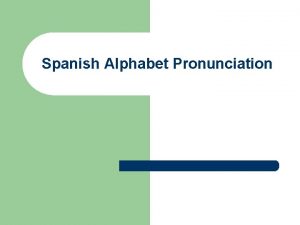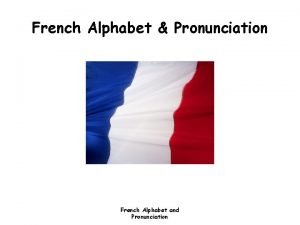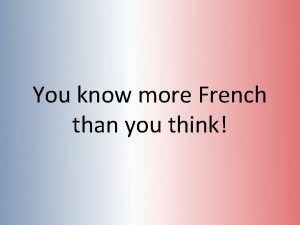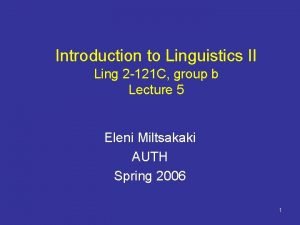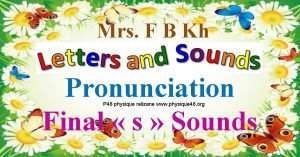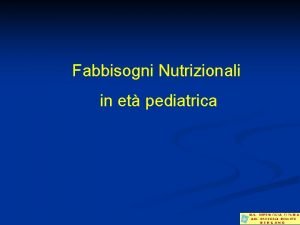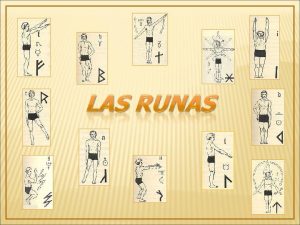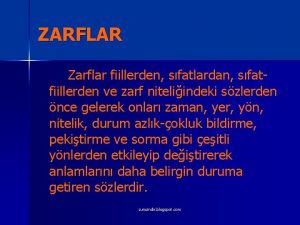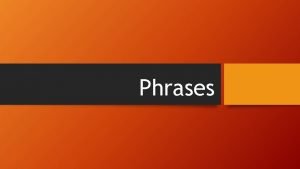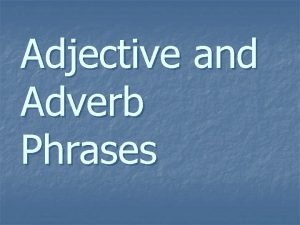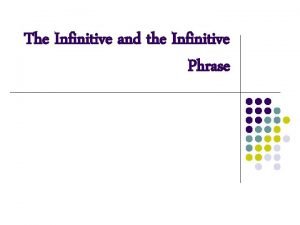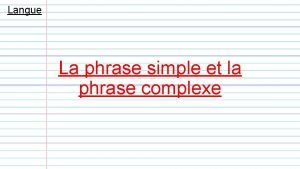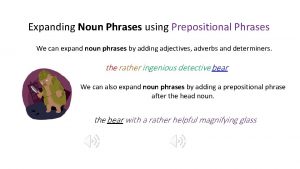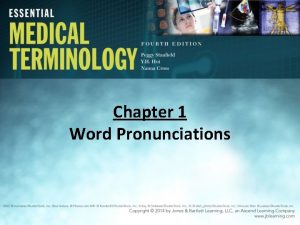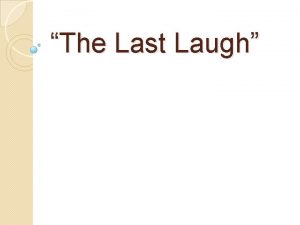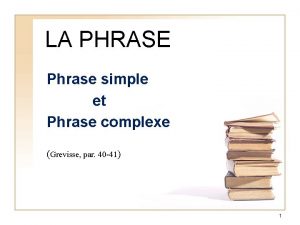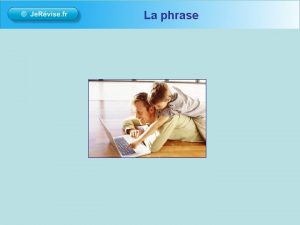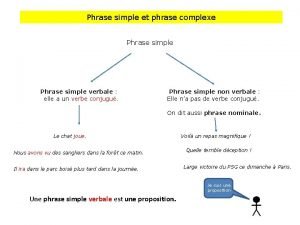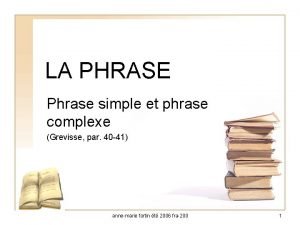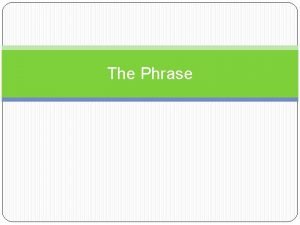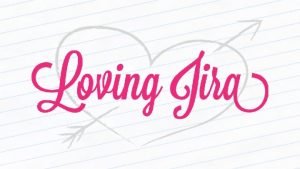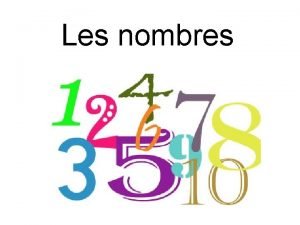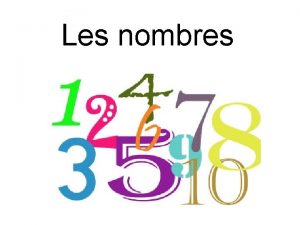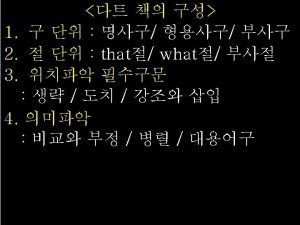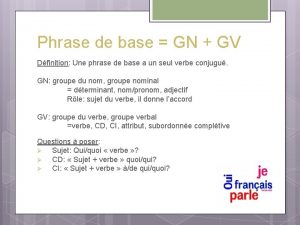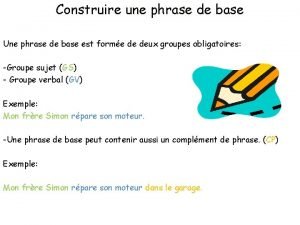Learning Pronunciations Laugh is pronounced laf Phrase is


















- Slides: 18

Learning Pronunciations Laugh is pronounced laf. Phrase is pronounced fraze. Wreck is pronounced rek. Unfortunately, very few English words are spelled the way they are pronounced.

The dictionary comes to the rescue!!!! In dictionaries, pronunciations are indicated by pronunciation spellings, which are enclosed in parentheses and placed immediately after entry words. The following entry provides two pronunciations for dour (dŏŏr, dour) adj. 1. Marked by intractable sternness or harshness; forbidding. 2. Silently ill-humored; gloomy. – See Synonyms at glum. [Middle English. Perhaps from Latin dūrus, hard. See deru- in Appendix. *] The pronunciation spelling for dour are (dŏŏr)lure and (dour)hour. When more than one pronunciation is given, the first is presumed to be common, but all pronunciations listed are equally acceptable.

Consonants and Vowels Consonants are usually said to be all the letters of the alphabet except a, e, i, o, u, and y, which may function as a consonant or a vowel. When words are spoken, consonants are the speech sounds produced by stopping breath or by forcing breath through a loose or narrow passage, and vowels are speech sounds produced by using a free flow of breath. There are only twenty-six letters in the English alphabet, but there approximately forty-five sounds used to produce English words. Pronunciation keys differ slightly from dictionary to dictionary.

Consonants – Exercise 5. 1 Consonants letters are used to represent consonant sounds in pronunciation spellings. For example, the letters h and t represent consonant sounds in hit (hit), and the letters s, t, r, and p represent consonant sounds in strap (strap). Is your brain beginning to turn (think) ?

The letters c, q, and x are not used in pronunciation spellings. c is usually pronounced k as in (kan) OR s, as in cent (sent). q is usually pronounced kw, as in quit (kwit) x is usually pronounced ks as in tax (taks) The following four words illustrate that pronunciation spellings often look very different from correct English spellings. wrap (rap) knit (nit) his (hiz) gin (jin) --Leave slide up & complete—Exercise 5. 1

Consonant Digraphs 5. 2 n Consonant digraphs are combinations of consonants that are pronounced as single sounds. There are five common consonant digraphs. ch as in chip ng as in wing sh as in ship th as in this (chip) (wing) (ship) (thin) (this)

ch as in chip ng as in wing sh as in ship th as in this (chip) (wing) (ship) (thin) (this) Notice that th in the pronunciation spelling of thin (thin) is not italicized, but it is italicized in the pronunciation spelling of this (this). Pronounce thin and this to recognize the two ways in which th is pronounced. The th in (thin) is voiceless, which means that the vocal cords do not vibrate to pronounce it. On the other hand, the th in (this) is voiced-the vocal cords do vibrate to pronounce it. (Put your hand on your throat as you speak thin and this. Do you feel the subtle difference? ) The sixth consonant digraph is zh, which is heard in words such as measure. (Not used as commonly as the five above. )

Try it!!! Put your hand on your vocal chords as you speak the following: chill shall thick bang than You need to have your hand right on your vocal chord to detect the movement. –Complete 5. 2 – Oral Assessment

Long and Short Vowels 5. 3 -5. 4 The letters a, e, i, o and u are used for most vowel sounds in pronunciation spelling. However, since there are only five vowel letters to represent approximately twenty vowel sounds, marks are used above vowels to indicate how they are pronounced. n Long vowels are the sounds that rhyme with the letters a, e, i, o, and u. Say the letters a, e, i, o, and u aloud. The sounds you said when you named the vowels are their long sounds. The following pronunciation spellings illustrate that most long vowel sounds are indicated by a mark called a macron (ˉ). hate (hāt) goat (gōt) beat (bēt) cute (kyōōt) kite (kīt) Notice that the long sound of u is indicated differently from the other long vowels, because it begins with the consonant sound y, as in you. n

n n Short vowels are the sounds that are usually heard in three-letter words that begin and end with a consonant. Say the words hat, bet, kit, got, and cut aloud. The vowel sounds in these words are the short vowels. Some dictionaries use no mark to indicate short vowels. Other dictionaries use a mark called a breve (˘) to indicate short vowel sounds. hat (hăt) bet (bĕt) kit (kĭt) got (gŏt) cut (kŭt) If you have difficulty hearing the short sounds of vowels, memorize these words: add, egg, it, odd, and up. --Complete Exercise 5. 3 & 5. 4 (Next slide up!!)

LONG VOWELS hate (hāt) goat (gōt) beat (bēt) cute (kyōōt) kite (kīt) SHORT VOWELS hat (hăt) bet (bĕt) kit (kĭt) got (gŏt) cut (kŭt)

n The Dieresis and Circumflex In addition to its long and short 5. 5 sounds, a has a sound Vowels that is indicated by a mark called a dieresis (¨). a as in arm (ärm) The vowels a, i, o, and u all have sounds that are indicated by a mark called circumflex (ˆ). a as in hair (hâr) i as in here (hîr) o as in law (lô) u as in verb (vûrb) In some parts of the country the a sound in arm (ärm) and the o sound in law (lô) are pronounced as though they are the same sound. --Complete Exercise 5. 5 (Keep this slide up!!)

Four More Vowel Sounds 5. 6 n The vowel o has two sounds in addition to the ones indicated by the macron (ē) breve (˘), and circumflex (ô). oo as in blue (bloo) ŏŏ as in book (bŏŏk) One way to remember these sounds is to visualize the pronunciation spelling of blue book (bloo bŏŏk). Finally, there are two dipthongs. A diphthong is two vowel sounds that are blended and pronounced together. oi as in boy (boi) ou as in scout (skout) To understand the characteristics of diphthongs, pronounce bow (bō) and then very slowly pronounce boy (boi). If you listen carefully, you should hear that the vowel sound in boy is the sound of long o (ō) blended with the sound of long e (ē). You may remember the dipthongs oi and ou by visualizing the pronunciation spelling of boy scout (boi skout). --Complete Exercise 5. 6 (Keep this slide up!)

Syllables, Stress, and the Schwa 5. 7 -5. 8 A syllable is a word or a part of a word that is pronounced as one unit. Big, red, and hat are examples of one-syllable words; they are all pronounced as one unit. The following words are printed with spaces between their syllables. beau ty beau ti fi ca tion Say these words aloud to hear the two syllables in beauty, three syllables in beautify, and five syllables in beautification. n

When words have more than one syllable, one of the syllables is spoken with more stress. n Stress is a general term that refers to the force with which syllables are spoken. n Primary stress refers to the greater force with which one syllable is spoken in comparison with another syllable or other syllables in a word; it is indicated by a primary accent mark ( ). Primary accent marks in the following words indicate which syllables receive primary stress when they are spoken. ga rage beau ty Say garage and beauty aloud, giving primary stress to the syllables with the primary accent marks.

n Secondary stress is weaker than primary stress but stronger than stress given to unstressed, or unaccented, syllables; it is indicated by a secondary accent mark( ). Primary and secondary accent marks in the following words indicate which syllables receive primary and secondary stress. rec og nize in dis pen sa ble Say recognize and indispensable aloud, giving primary and secondary stress to the syllables with the primary and secondary accent marks.

The syllables with no accent marks in recognize and indispensable are unstressed syllables. n The vowel sounds in unstressed syllables are often indicated by a symbol called a schwa. The schwa looks like the letter printed upside down (ə); it has the vowel sound heard in of when the phrase “bag of candy” is said quickly (băg əv kăn de). n The following pronunciation spellings illustrate how accent marks and the schwa are used. recognize (rĕk əg-nīz ) indispensable (ĭn dĭs-pĕn sə-bəl)

n In recognize the schwa represents a sound spelled by the letter o, and in indispensable schwas represent sounds spelled by the letters a and e. The schwa may represent sounds that are spelled by any vowel and by combinations of vowels. For example, the schwa represents the sound spelled by the letters ai in the mountain (moun tən). Exercise 5. 7 explains how to divide two-syllable words. Read 5. 7 and then complete 5. 8. --Complete Exercise 5. 8 Guided by correct pronunciation, read Exercise 5. 9 words aloud to a partner.
 Spanish alphabet az
Spanish alphabet az French alphabet with phonetics
French alphabet with phonetics Words that are spelled the same but pronounced differently
Words that are spelled the same but pronounced differently Words that are spelled the same but pronounced differently
Words that are spelled the same but pronounced differently Van gogh pronounce
Van gogh pronounce S z iz
S z iz Laf dimnjak
Laf dimnjak Calcolo calorie
Calcolo calorie Runa not
Runa not Tempo digestione pasta
Tempo digestione pasta çok mal haramsız çok laf yalansız olmaz
çok mal haramsız çok laf yalansız olmaz Laf larn
Laf larn Cuadro comparativo de e-learning b-learning y m-learning
Cuadro comparativo de e-learning b-learning y m-learning Phrase
Phrase Adverb phrase vs adjective phrase
Adverb phrase vs adjective phrase What is an infinitive verb
What is an infinitive verb Groupe verbal exemple
Groupe verbal exemple Phrase juxtaposée exemple
Phrase juxtaposée exemple Prepositional phrase
Prepositional phrase
